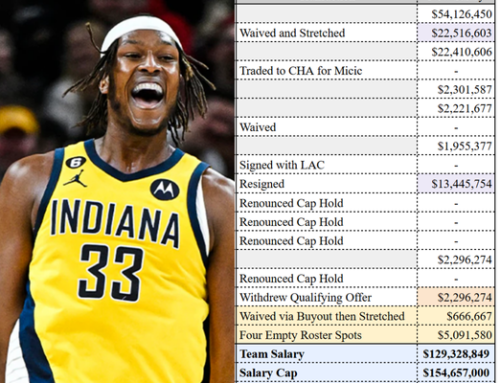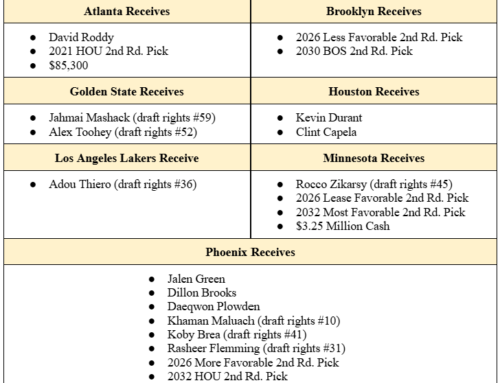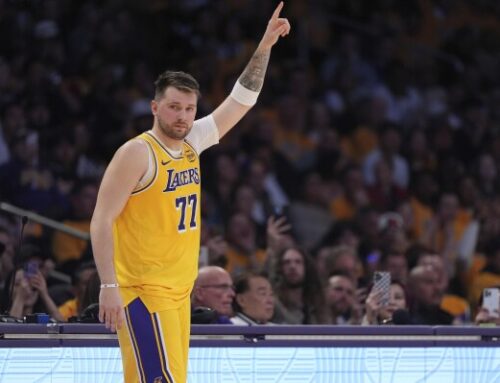One of the hotter trade rumors circling in the NBA this offseason involved Lauri Markkanen of the Utah Jazz. But Markkanen is in a rare scenario, where he is an underpaid player entering the final season of his contract with a team with enough Cap Space to renegotiate and extend his contract if they see fit. This creates options for Utah, but there are some CBA restrictions for both Utah and any potential team acquiring Markkanen in the future.
Let’s dive in.
Transactions Available
Below are the two transactions I will discuss. I will first explain the date restrictions implemented by the CBA on these transactions. I will then break down the contract limitations (e.g. salary, years, etc.) based on each transaction and how that may affect the likelihood Markkanen agrees to a deal or waits until free agency.
The two transactions are:
- Renegotiate-and-Extend between Utah and Markkanen;
- Trade Markkanen on Existing Contract (potential Extension after Trade)
Dates Restricting Transactions
Renegotiate-and-Extend: Eligible 8/6/24
The most likely option is to renegotiate Markannen’s current contract of $18,044,544 and then extend his contract for additional years. Markkanen is renegotiation-eligible beginning August 6th (i.e. the third anniversary* of signing his current contract).
This locks Markkanen in long-term on a salary correlated to his current production.
Many would think this also makes him more tradeable, given there’s no risk he can leave in the offseason. But there’s a catch. The CBA allows Extend-and-Trades, but it does not allow Renegotiate-and-Trades. Once his contract is renegotiated, he can’t be traded for six months.
The Trade Deadline just so happens to be February 6th this season. If there was an intention to trade his renegotiated contract this season, Utah must renegotiate him on August 6th. If Markannan wants to avoid being involved in trade discussions the entire season (like he is this offseason), he simply needs to wait until August 7th to sign his renegotiated contract and he will have an implied No Trade Clause for this season.
Trade (no Renegotiation)
If Utah doesn’t renegotiate his contract, they have the freedom to trade his contract at any time this offseason up to the trade deadline. One would think that if this was going to happen, Markkanen would already have landed elsewhere and therefore Utah has likely pivoted to renegotiation talks.
One note on date restrictions: If traded, the acquiring team will have more stringent extension limitations the first six months after trading for him. However, because Markkanen likely wouldn’t agree to even the highest extension permissions (140% increase of prior salary) it is likely a moot point. More on this below.
Contract Restrictions
Renegotiation
When renegotiating a Player’s salary, the team is limited by its own Cap Space and by the player’s applicable salary allowable by the CBA. Here, Utah has roughly $35 million in available Cap Space. Markkanen’s current maximum salary for the Renegotiated Season (2024-2025) is $42,176,400. Because Utah has enough Cap Space to increase Markkanen’s salary from $18,044,544 to $42,176,400, they could offer him a new maximum contract. A full maximum contract would be for five years (including the Renegotiated Season), totaling $244 million dollars.
Trade
As stated briefly above, an acquiring team has some significant limitations upon acquiring Markkanen. If they don’t have any Cap Space, then they simply cannot renegotiate Markkanen’s contract the same way Utah can. They are then limited to the Veteran Extension rules. For the first six months after the trade, they could only increase his prior salary 120% ($21,653,452) in the first year of his extended term, and offer a maximum of four years and 5% raises. After six months, the limitations increase, but are still well below Markkanen’s maximum salary. They could offer him 140% ($25,262,361) of his prior salary for up to five seasons and 8% raises.
The one benefit in trading for Markkanen (other than his services for the 2024-2025 Season) is obtaining his full Bird Rights. This would allow the acquiring team to sign him up to his maximum salary in the offseason when he enters free agency. Allowing the player to enter free agency is a risky proposition. But somehow these teams tend to know if they’ll be able to resign these players before making the trade. Because of the expected 10% increase in the Salary Cap, Markkanen’s starting salary in 2025-2026 could be as high as $46,394,040. Any team with Bird Rights could sign him to five years and 8% raises, for a maximum total salary of $269,085,432.
Conclusion
The most likely scenario here is a renegotiation and extension, as it is unlikely a team is willing to trade significant assets for a one-year player. Utah can’t lose Markkanen for nothing, and can likely maximize his trade value with an extension even if they have to wait to trade him. Utah has the benefit of time, as they can assess their young talent alongside Markkanen this season and decide whether he will be a good fit long term or whether a trade in the 2025 offseason makes sense. The major downside for Utah might be the generation of additional wins with Markkanen on your roster when you’re not a title contender and you’ll be entering a strong draft next offseason. But failing to maximize the return for your start player is a far bigger risk,
*Markkanen’s actual signing date was August 26, 2021, but the COVID-delayed season applied retroactive effective date for purposes of the Salary Cap rules.





